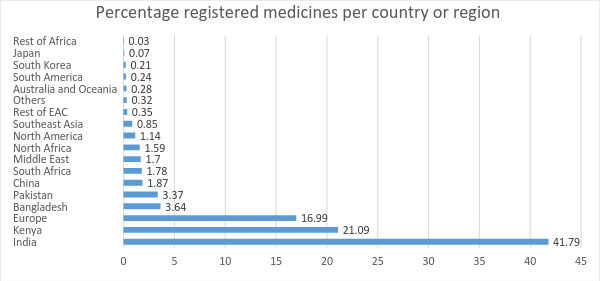Home > African Marke > Kenya
Time: Aug 9, 2016
Kemsa and Procurement Policies
In 2015, the Global Fund disbursed the following amounts visible in the table below in USD to KEMSA for procurement. The Global Fund is the leading development partner, funded by other large donor agencies, in the pharmaceutical industry in Kenya. The fund subsidizes a large majority, if not all, of the main infectious diseases (malaria/HIV/TB/Family Planning) medical supplies with the aim of creating accessible and affordable drugs for all Kenyans. Due to Global Fund, and other donor supplies in certain areas of the pharmaceutical industry, the commercial private sector is being faced off as they cannot compete with the strongly subsidized supplies that are now available.
HIV Program | Amount (USD) |
1. ARV medicine | 16,144,456.00 |
2. Methadone | 321,156.00 |
3. HIV test kit | 1,661,648.00 |
TB Program | |
1. Anti-TB medicines | 2,291,556.00 |
2. Laboratory consumables | 190,965.35 |
Malaria program | |
1. Sulphadoxine tablets x 1000 | 547,200.00 |
2. Microscopes | 1,410,000.00 |
3. PH meters | 528,750.00 |
4. Electronic Balance | 775,500.00 |
5. Laboratory supplies and consumables | 111,095.50 |
Table x: Global Fund Supported Grants for HIV/TB and Malaria
The national public procurement partner, KEMSA, has been experiencing a rise in its sales since the devolution has come in practice. Prior to 2013, providing public medical services was a role of the central/national government. After the passing of the new constitution healthcare became devolved to the counties. This meant that each county government was responsible for the healthcare provision in their jurisdiction. This allowed counties to have a greater flexibility in the control of their budgets and purchases 分销.
In the first year after devolution, 2013/2014, the turnover of KEMSA was Kshs. 2.2b whereas the following year, 2014/2015, the turnover was Kshs. 4b. The hope is to reach Kshs. 5b in the year 2015/2016.
In Kenya, about 70% of the pharmaceuticals are locally procured and 30% imported. For non-pharmaceutical medical supplies the local procurement stands much lower at 30% versus imported supplies at 70%.

Figure x: Percentage registered medicines by Country or Region[1]
Figure x above shows the percentage of medicines registered with the PPB by Country or Region. Only 1.87% of the medicines registered in Kenya are made in China. India imports registered with PPB account for 41.79%. Europe has the third highest imports in Kenya at 16.99%.
All the 47 county governments procure their pharmaceutical supplies from KEMSA, MEDS, FBOs or from the commercial private sector. For all public facilities KEMSA is appointed as the first point of procurement which means that public facilities can only procure supplies from others when KEMSA does not have the supplies in stock or does not supply the pharmaceuticals needed.
[1] PPB

